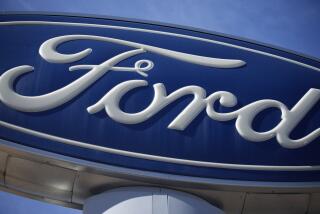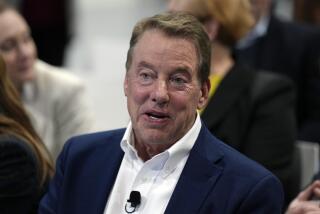Following Customers’ Lead : Ford Gambles on Styling to Regain Lost Consumers
- Share via
For Ford Motor Co., the nadir of the auto industry’s slump may have come on a rainy day in late 1980.
That’s when Ford asked a few consumers into its design center in Dearborn, Mich., to get their reactions to Ford’s future products.
At one point during the session, three proposed versions of Ford’s 1983 Thunderbird were lined up in front of the audience. All three were almost identical to the boxy-looking 1980 model T-Bird, which in turn was similar to many other Ford products of the period.
Despite plummeting sales and mounting losses, it was clear that day that Ford had no intention of changing its ways.
Then a member of the audience stood up. “I know,” the consumer said, “that these are all phony. The real car is behind the curtain back there, isn’t it?”
But there wasn’t anything behind the curtain, and the Ford people didn’t know what to say.
“I’ll never forget that moment as long as I live,” says Allan Gilmour, Ford’s vice president for external and personnel affairs. “After that, we threw out all the old designs and started over.”
In many ways, Ford has been climbing out of that deep hole ever since. Through a combination of severe cost-cutting measures and rising sales volume over the last four years, Ford has moved from record losses of $1.5 billion in 1980 to record profits of an estimated $2.9 billion in 1984, allowing the company to ease the huge debt burden it had taken on during the recession.
Its break-even point in North America has been reduced by 40% since 1980, which will make it easier for Ford to remain profitable even if car sales slump sometime in the next several years.
Its car sales in the United States increased 34% during the past four years, and the company finally halted the long slide in its share of the domestic auto market. In the last year, its share has actually risen to its highest level since 1979, and Ford is retaking ground previously given up to General Motors Corp. and the Japanese.
“They have taken advantage of the renewed strength in the market pretty effectively over the last couple of years,” observes David Healy, an automotive analyst with the investment firm of Drexel Burnham Lambert Inc. in New York.
Meanwhile, Ford has tried to break with its styling of the past by using wind-swept, aerodynamic designs on a whole series of new products, including the 1986 Ford Taurus and Mercury Sable front-wheel-drive intermediate-sized models. Those cars were introduced Tuesday at a Hollywood-style celebration at the MGM movie studios in Culver City by Ford Chairman Philip Caldwell, 65, who is retiring at the end of the week, and by Ford President Donald E. Petersen, 58, who will succeed Caldwell.
“We decided five years ago that we needed to try harder to learn what our customers wanted and to follow their lead with our product designs--and not to worry so much about how different that might make us, compared with our competition,” Petersen said.
Ford is charting a separate course in design, notes David Cole, director of the Center for the Study of Automotive Transportation at the University of Michigan, and “that is a risk in a mass-volume business, but so far it seems to be working,”
Quality Still Lags
Still, as Ford undergoes its leadership transition this week, many of Ford’s most serious problems remain unresolved.
Despite its improved sales and market share, Ford still could not compete head-to-head with the Japanese if import restraints were lifted, analysts believe.
Ford’s much-ballyhooed push to improve the quality of its cars and trucks to better compete with the Japanese has not yet accomplished its goal. Independent consumer surveys show that car buyers believe that Ford’s quality has gotten better but still lags behind many imports. Even Philip Benton, Ford’s vice president for sales, conceded this week that Ford’s quality isn’t yet up to that of Toyota Motor Co. or Honda Motor Co.
That’s especially bad news for Ford because it relies much more heavily on import-sensitive sales of subcompact and compact cars than does GM, and so stands to lose a hefty chunk of its market share once quotas on Japanese cars are lifted. (The Reagan Administration plans to decide by the end of the first quarter whether to seek a fifth year of the quotas.)
But GM poses as much of a threat to Ford as the Japanese. GM, held back last year by product shortages because of strikes in the United States and Canada and a series of lengthy plant shutdowns for model changeovers, is expected to eat into Ford’s sales this year, when it is no longer burdened by capacity problems.
Ford appears especially vulnerable to inroads from GM in the upper end of the car market, where many of Ford’s older, rear-wheel-drive models are competing directly against GM’s newly redesigned front-wheel-drive big cars.
“Our feeling is that Ford’s market share was artificially bolstered last year by GM’s supply problems, and so we are forecasting some give-up by Ford in 1985,” says Harvey Heinbach, automotive analyst with Merrill Lynch in New York.
Overseas, Ford’s once-lucrative European operations are struggling, despite the fact that Ford took over sales leadership in the fiercely competitive European market last year for the first time ever.
Analysts say Ford of Europe is just breaking even, while the company’s U.S. operations are bringing in most of the corporation’s profits. But some analysts believe that those U.S. profits will be squeezed this year, when Ford is forced to pay a higher tax rate as it runs out of tax benefits built up as a result of its losses during the recession. They expect Ford’s earnings to decline to about $2.4 billion in 1985.
To offset many of its continuing weaknesses, Ford is counting heavily on a rather unorthodox future product program, which combines a greater reliance on imports with an expanded commitment to aerodynamic styling on its U.S.-built cars.
In an effort to bolster its position at the low end of the market, in 1987 Ford will begin importing a new small car from a Mexican plant to supplement its U.S.-built Ford Escort and Mercury Lynx subcompacts.
The company is also studying the possibility of importing a minicar from its Japanese partner, Mazda Motors Corp., and also might buy compact cars from Mazda after the Japanese firm begins production at its U.S. plant outside Detroit in 1987. (But, while it relies on imports in the small-car market for the next few years, Ford has begun a crash program, known as Project Alpha, that, like GM’s Saturn Project, is charged with developing cost-competitive U.S.-built small cars for the late 1980s or early 1990s.)
To attract more affluent import-oriented buyers, meanwhile, Ford has just begun to import the Merkur, a luxury sports coupe built by Ford of Germany, and eventually plans to offer an entire line of Merkur-brand upscale imports.
Taurus-Sable Crucial
This summer, Ford will also introduce the Ford Aerostar, Ford’s first entry in the expanding minivan market.
Still, much of Ford’s future will be riding on the success of the $3-billion Taurus-Sable product program, which will carry Ford’s new emphasis on aerodynamic styling into the crucial family car market. Taurus and Sable are designed to appeal to young professionals with children more directly than the older Ford LTD and Mercury Marquis, which will be dropped about six months after the Taurus and Sable go on sale next fall. Eventually, Ford hopes those models will account for more than 25% of its annual volume, committing Ford to aerodynamic styling throughout the bulk of its lineup.
But if the new models aren’t widely accepted by Ford’s older, more traditional family car buyers--or if import buyers aren’t won over by the design of the Taurus-Sable models--Ford could be in serious trouble, analysts believe.
“Ford is in good financial shape, which wasn’t true a couple years ago, but things on the product side look a little uncertain,” says Heinbach of Merrill Lynch. “The Taurus is critical for them. Compared to GM, Ford is weak at the top of its lineup, and if Taurus isn’t successful, I don’t see anything coming along after that to back it up.”
Ford Motor Co. Performance
Car sales Year in U.S. 1984 1,979,317 1983 1,571,321 1982 1,345,698 1981 1,380,600 1980 1,475,231 1979 2,140,368






